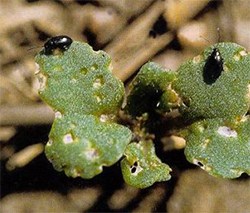As the growing season begins farmers need to closely monitor and protect their crop from potential insect problems. Early in the growing season the plants can be extremely vulnerable to insect threats and close observation is required. With a canola crop; flea beetles or cutworms can devastate a seedling crop in just a few days.
Conversely, it is extremely important to understand that a few insects or a small amount of damage may not warrant action.
The question to ask is how many insects are too many? The temptation may be to spray as soon as insects are found, but making the correct decision is not that easy! Controlling insects is costly. The cost of controlling the insect must include all factors such as fuel, actual application cost and time/labour associated with operating the machine, not just the price of the chemical. Most insecticides have broad spectrum activity and will affect both the target and non-target (beneficial) insects. Therefore, unnecessary applications can have undesirable environmental effects.
“Economic thresholds” is a term that describes the density of insects at which control measures should be applied to prevent an increasing population from reaching the economic injury level. This economic injury level is when the damage caused by the insect is equal to the cost of preventing the damage/controlling the insect. Economic thresholds or ET’s will vary depending on a combination of factors including pest, crop type, growth stage, expected market value and cost of control.
Insect populations tend to vary throughout a field. When scouting crops, it is important to consider these variations.
Depending on the pest, insect numbers and species composition, often field margins will differ considerably from populations within the field. Hills and low-lying parts of the field will also differ. Increasing the number of sampling sites in a field will improve accuracy when estimating insect populations and can help reduce application costs by targeting control only where it is needed.
Some economic thresholds are based on scientific research while others are nominal and based on the best information available. ETs should be considered as a guide and will vary depending on the market value of the crop and the cost of control. Ultimately the decision to spray or not comes down to the producer, however economic thresholds are a tool in the decision making process.
Remember: It is critical to know the insect pest you are dealing with. Have it properly identified to determine the best control measure.
For more information on economic thresholds or information contact your Regional Crops Specialist; or
• Contact the Agriculture Knowledge Centre at 1-866-457-2377
• Visit Saskatchewan Agricultures “Economic Thresholds of Insect Pests” at http://www.agriculture.gov.sk.ca/Default.aspx?DN=a4d74761-d683-4e68-8c5e-60f592bc4ee8
Lyndon Hicks PAg
Regional Crops Specialist
Yorkton




